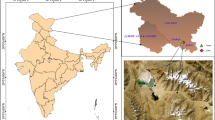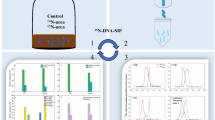Abstract
This study investigated the change of CH4 production and methanogenic community in response to the presence of humic substances (humics) analogue, anthraquinone-2,6-disulfonate (AQDS). Anaerobic experiments used a Chinese paddy soil, and three concentration levels of 0.5, 5, and 20 mM AQDS were conducted. Results suggested that the effect of AQDS on methanogenesis was time-dependent and concentration-dependent. Twenty millimolars of AQDS was toxic for methanogenic activity almost for the entire experimental period. Slight inhibition of methanogenesis by AQDS respiration in the 0.5- and 5-mM AQDS-supplemented treatments occurred within the early period, while CH4 accumulated throughout the later period was approximately five and ten times greater than that of the controls without AQDS, respectively. AQDS reduction coupling to acetate oxidization enriched Geobacter species, and the mcrA-targeted T-RFLP profiles revealed significant increase of Methanosarcina at the expense of Methanobacterium in the 0.5- and 5-mM AQDS treatments. The enriched syntrophic association between Geobacter and Methanosarcina was deduced to be an effective methanogenic pathway for converting acetate to CH4 via direct interspecies electron transfer. This study implied the ecological importance of syntrophic interaction between methanogens and microorganisms enriched by anaerobic respiration of non-methanogenic terminal electron acceptors in paddy soils.






Similar content being viewed by others
References
Barbier BA, Dziduch I, Liebner S, Ganzert L, Lantuit H, Pollard W, Wagner D (2012) Methane-cycling communities in a permafrost-affected soil on Herschel Island, Western Canadian Arctic: active layer profiling of mcrA and pmoA genes. FEMS Microbiol Ecol 82:287–302
Blodau C, Deppe M (2012) Humic acid addition lowers methane release in peats of the Mer Bleue bog, Canada. Soil Biol Biochem 52:96–98
Bond DR, Lovley DR (2002) Reduction of Fe(III) oxide by methanogens in the presence and absence of extracellular quinones. Environ Microbiol 4:115–124
Boone DR, Johnson RL, Liu Y (1989) Diffusion of the interspecies electron carriers H2 and formate in methanogenic ecosystems and its implications in the measurement of Km for H2 or formate uptake. Appl Environ Microbiol 55:1735–1741
Bridgham SD, Johnston CA, Pastor J, Updegraff K (1995) Potential feedbacks of northern wetlands on climate change. BioScience 45:262–274
Bridgham SD, Updegraff K, Pastor J (1998) Carbon, nitrogen, and phosphorus mineralization in northern wetlands. Ecology 79:1545–1561
Briones AM (2012) The secrets of El Dorado viewed through a microbial perspective. Front Microbiol 3:239
Cervantes FJ, Velde S, Lettinga G, Field JA (2000) Competition between methanogenesis and quinone respiration for ecologically important substrates in anaerobic consortia. FEMS Microbiol Ecol 34:161–171
Chin KJ, Lueders T, Friedrich M, Klose M, Conrad R (2004) Archaeal community structure and pathway of methane formation on rice roots. Microb Ecol 47:59–67
Coates JD, Ellis DJ, Blunt-Harris EL, Gaw CV, Roden EE, Lovley DR (1998) Recovery of humic-reducing bacteria from a diversity of environments. Appl Environ Microbiol 64:1504–1509
Conrad R (1999) Contribution of hydrogen to methane production and control of hydrogen concentrations in methanogenic soils and sediments. FEMS Microbiol Ecol 28:193–202
Frey B, Niklaus PA, Kremer J, Lüscher P, Zimmermann S (2011) Heavy-machinery traffic impacts methane emissions as well as methanogen abundance and community structure in oxic forest soils. Appl Environ Microbiol 77:6060–6068
Garcia JL, Patel B, Ollivier B (2000) Taxonomic, phylogenetic, and ecological diversity of methanogenic Archaea. Anaerobe 6:205–226
Hales BA, Edwards C, Ritchie DA, Hall G, Pickup RW, Saunders JR (1996) Isolation and identification of methanogen-specific DNA from blanket bog peat by PCR amplification and sequence analysis. Appl Environ Microbiol 62:668–675
Heitmann T, Goldhammer T, Beer J, Blodau C (2007) Electron transfer of dissolved organic matter and its potential significance for anaerobic respiration in a northern bog. Global Change Biol 13:1771–1785
Holmes DE, Finneran KT, O'Neil RA, Lovley DR (2002) Enrichment of members of the family Geobacteraceae associated with stimulation of dissimilatory metal reduction in uranium-contaminated aquifer sediments. Appl Environ Microbiol 68:2300–2306
Hori T, Müller A, Igarashi Y, Conrad R, Friedrich MW (2009) Identification of iron-reducing microorganisms in anoxic rice paddy soil by 13C-acetate probing. ISME J 4:267–278
Joulian C, Ollivier B, Patel B, Roger PA (1998) Phenotypic and phylogenetic characterization of dominant culturable methanogens isolated from ricefield soils. FEMS Microbiol Ecol 25:135–145
Kato S, Hashimoto K, Watanabe K (2012) Methanogenesis facilitated by electric syntrophy via (semi) conductive iron-oxide minerals. Environ Microbiol 14:1646–1654
Kato S, Nakamura R, Kai F, Watanabe K, Hashimoto K (2010) Respiratory interactions of soil bacteria with (semi) conductive iron-oxide minerals. Environ Microbiol 12:3114–3123
Keller JK, Bridgham SD (2007) Pathways of anaerobic carbon cycling across an ombrotrophic-minerotrophic peatland gradient. Limnol Oceanogr 52:96–107
Keller JK, Weisenhorn PB, Megonigal JP (2009) Humic acids as electron acceptors in wetland decomposition. Soil Biol Biochem 41:1518–1522
Kim SY, Lee SH, Freeman C, Fenner N, Kang H (2008) Comparative analysis of soil microbial communities and their responses to the short-term drought in bog, fen, and riparian wetlands. Soil Biol Biochem 40:2874–2880
Lal R (2004) Soil carbon sequestration impacts on global climate change and food security. Science 304:1623–1627
Liu F, Rotaru AE, Shrestha PM, Malvankar NS, Nevin K, Lovley DR (2012) Promoting direct interspecies electron transfer with activated carbon. Energy Environ Sci 5:8982–8989
Lovley DR (2011) Live wires: direct extracellular electron exchange for bioenergy and the bioremediation of energy-related contamination. Energy Environ Sci 4:4896–4906
Lovley DR (2011) Reach out and touch someone: potential impact of DIET (direct interspecies energy transfer) on anaerobic biogeochemistry, bioremediation, and bioenergy. Rev Environ Sci Biotechnol 10:101–105
Lovley DR, Coates JD, Blunt-Harris EL, Phillips EJP, Woodward JC (1996) Humic substances as electron acceptors for microbial respiration. Nature 382:445–448
Lueders T, Pommerenke B, Friedrich MW (2004) Stable-isotope probing of microorganisms thriving at thermodynamic limits: syntrophic propionate oxidation in flooded soil. Appl Environ Microbiol 70:5778–5786
Megonigal JP, Hines ME, Visscher PT (2003) Anaerobic metabolism: linkages to trace gases and aerobic processes. In: Schlesinger WH (ed) Treatise on geochemistry, vol. 8. Elsevier-Pergamon, Oxford, pp 317–424
Minderlein S, Blodau C (2010) Humic-rich peat extracts inhibit sulfate reduction, methanogenesis, and anaerobic respiration but not acetogenesis in peat soils of a temperate bog. Soil Biol Biochem 42:2078–2086
Morita M, Malvankar NS, Franks AE, Summers ZM, Giloteaux L, Rotaru AE, Rotaru C, Lovley DR (2011) Potential for direct interspecies electron transfer in methanogenic wastewater digester aggregates. MBio 2:e00159–00111
Neubauer SC, Givler K, Valentine SK, Megonigal JP (2005) Seasonal patterns and plant-mediated controls of subsurface wetland biogeochemistry. Ecology 86:3334–3344
Nevin KP, Kim BC, Glaven RH, Johnson JP, Woodard TL, Methé BA, DiDonato RJ, Covalla SF, Franks AE, Liu A (2009) Anode biofilm transcriptomics reveals outer surface components essential for high density current production in Geobacter sulfurreducens fuel cells. PLoS One 4:e5628
Ng WL, Schummer M, Cirisano FD, Baldwin RL, Karlan BY, Hood L (1996) High-throughput plasmid mini preparations facilitated by micro-mixing. Nucleic Acids Res 24:5045–5047
Nunoura T, Oida H, Miyazaki J, Miyashita A, Imachi H, Takai K (2008) Quantification of mcrA by fluorescent PCR in methanogenic and methanotrophic microbial communities. FEMS Microbiol Ecol 64:240–247
Pansu M, Gautheyrou J (2006) Handbook of soil analysis: mineralogical, organic and inorganic methods. Springer, The Netherlands
Reguera G, McCarthy KD, Mehta T, Nicoll JS, Tuominen MT, Lovley DR (2005) Extracellular electron transfer via microbial nanowires. Nature 435:1098–1101
Reguera G, Nevin KP, Nicoll JS, Covalla SF, Woodard TL, Lovley DR (2006) Biofilm and nanowire production leads to increased current in Geobacter sulfurreducens fuel cells. Appl Environ Microbiol 72:7345–7348
Roden EE, Kappler A, Bauer I, Jiang J, Paul A, Stoesser R, Konishi H, Xu H (2010) Extracellular electron transfer through microbial reduction of solid-phase humic substances. Nat Geosci 3:417–421
Rui J, Qiu Q, Lu Y (2011) Syntrophic acetate oxidation under thermophilic methanogenic condition in Chinese paddy field soil. FEMS Microbiol Ecol 77:264–273
Scott DT, McKnight DM, Blunt-Harris EL, Kolesar SE, Lovley DR (1998) Quinone moieties act as electron acceptors in the reduction of humic substances by humics-reducing microorganisms. Environ Sci Technol 32:2984–2989
Snoeyenbos-West O, Nevin K, Anderson R, Lovley DR (2000) Enrichment of Geobacter species in response to stimulation of Fe (III) reduction in sandy aquifer sediments. Microb Ecol 39:153–167
Springer E, Sachs MS, Woese CR, Boone DR (1995) Partial gene sequences for the A subunit of methyl-coenzyme M reductase (mcrI) as a phylogenetic tool for the family Methanosarcinaceae. Int J Syst Bacteriol 45:554–559
Stams AJM, De Bok FAM, Plugge CM, Van Eekert MHA, Dolfing J, Schraa G (2006) Exocellular electron transfer in anaerobic microbial communities. Environ Microbiol 8:371–382
Summers ZM, Fogarty HE, Leang C, Franks AE, Malvankar NS, Lovley DR (2010) Direct exchange of electrons within aggregates of an evolved syntrophic coculture of anaerobic bacteria. Science 330:1413–1415
Thauer RK (1998) Biochemistry of methanogenesis: a tribute to Marjory Stephenson. Microbiology 144:2377–2406
Tymensen LD, Beauchemin KA, McAllister TA (2012) Structures of free-living and protozoa-associated methanogen communities in the bovine rumen differ according to comparative analysis of 16S rRNA and mcrA genes. Microbiology 158:1808–1817
Updegraff K, Pastor J, Bridgham SD, Johnston CA (1995) Environmental and substrate controls over carbon and nitrogen mineralization in northern wetlands. Ecol Appl 5:151–163
van Bodegom PM, Scholten JCM, Stams AJM (2004) Direct inhibition of methanogenesis by ferric iron. FEMS Microbiol Ecol 49:261–268
Wang H, Vuorela M, Keränen A-L, Lehtinen TM, Lensu A, Lehtomäki A, Rintala J (2010) Development of microbial populations in the anaerobic hydrolysis of grass silage for methane production. FEMS Microbiol Ecol 72:496–506
Weber S, Lueders T, Friedrich MW, Conrad R (2001) Methanogenic populations involved in the degradation of rice straw in anoxic paddy soil. FEMS Microbiol Ecol 38:11–20
Yavitt JB, Seidman-Zager M (2006) Methanogenic conditions in northern peat soils. Geochem J 23:119–127
Acknowledgments
This study was funded by the National Natural Science Foundation of China (nos. 31070460 and 41171205) and Guangdong Natural Science Funds for Distinguished Young Scholar (S20120011151).
Author information
Authors and Affiliations
Corresponding authors
Rights and permissions
About this article
Cite this article
Xu, J., Zhuang, L., Yang, G. et al. Extracellular Quinones Affecting Methane Production and Methanogenic Community in Paddy Soil. Microb Ecol 66, 950–960 (2013). https://doi.org/10.1007/s00248-013-0271-7
Received:
Accepted:
Published:
Issue Date:
DOI: https://doi.org/10.1007/s00248-013-0271-7




